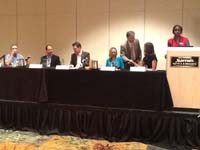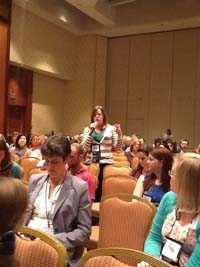Scientists Talk
By Lauren Jonas, NSTA Assistant Executive Director
Posted on 2013-04-13
 “It’s IMPOSSIBLE not to love science!” That’s what Dr. Rui Vogt Aives de Cruz told a group of several hundred science teachers Thursday at NSTA’s National Conference on Science Education. He and four other representatives from some of America’s top STEM employers urged them to communicate that message to their students.
“It’s IMPOSSIBLE not to love science!” That’s what Dr. Rui Vogt Aives de Cruz told a group of several hundred science teachers Thursday at NSTA’s National Conference on Science Education. He and four other representatives from some of America’s top STEM employers urged them to communicate that message to their students.
Moderated by NSTA’s Executive Director Dr. David L. Evans, NSTA’s New Science Teacher Academy hosted a roundtable discussion focused on how we make science real for students, and how we can connect scientists with students. Speakers included Dr. Larry Sernyk, from Dow; Dr. Mark Land, from Bayer; Dr. Rui Vogt Aives de Cruz, from Dow; Amy L. Gowder , from Lockheed Martin; and Jenny M. Kite, from Astellas.
 Why is this important? Jenny M. Kite told us what we all need to remember: Students will drive tomorrow’s innovation! Amy L. Gowder explained that 75% of Lockheed Martin employees need a science background, they need engineers, and it’s critical to the future of their company to have a pipeline. Rui Vogt Aives de Cruz made his passion for STEM clear and urged teachers to communicate their love of science to students, to show how science is applicable to their lives. Mark Land from Bayer (“we’re more than just aspirin!”) credited great teachers for getting him where he is today. Larry Sernyk from Dow echoed the praise for teachers, saying they were vital to his career.
Why is this important? Jenny M. Kite told us what we all need to remember: Students will drive tomorrow’s innovation! Amy L. Gowder explained that 75% of Lockheed Martin employees need a science background, they need engineers, and it’s critical to the future of their company to have a pipeline. Rui Vogt Aives de Cruz made his passion for STEM clear and urged teachers to communicate their love of science to students, to show how science is applicable to their lives. Mark Land from Bayer (“we’re more than just aspirin!”) credited great teachers for getting him where he is today. Larry Sernyk from Dow echoed the praise for teachers, saying they were vital to his career.
So what were some of the suggestions? If a teacher wants to approach a company to see if they can make connections between scientists and students, the panel recommended that teachers do a little legwork in advance—really think about what you want to accomplish and how a scientist could help. For instance, do you want someone to talk at career day? Or would you like your class to have a tour of a lab? Do you want them to explain how they got where they are? Are you looking for a specific kind of scientist who can explain a topic to your class?
The teachers asked questions, such as “How can you get students interested who may not pursue a 4-year degree”? The panel had a host of ideas—among them to let students shadow a scientist, and to show them careers that require STEM training, but not necessarily a 4-year degree. And in fact, when students start out pursuing a technical degree and become enthralled with the subject, they often go on to get a 4-year degree, or even go beyond.
The take-home message was for teachers to bring fresh ideas. Teachers know best what will appeal to students, and they should share them with companies that require their workers to have STEM training.
To learn more about the New Science Teacher Academy, which brings together these innovative companies and new science teachers, please go to: http://www.nsta.org/academy/. If you are a new science teacher or know someone who is, please consider the fellowship program—they are now accepting applications!
Disclaimer: The views expressed in this blog post are those of the author(s) and do not necessarily reflect the official position of the National Science Teaching Association (NSTA).

